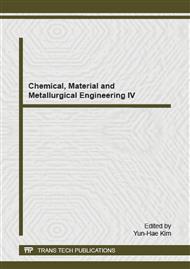[1]
Sommer. H. Durability of High Performance Concrete. 1998: 2-4.
Google Scholar
[2]
Ernst K, Tean F. PCT Int. A ppl: W O 95/257066. (1995).
Google Scholar
[3]
Weissenbach K, S tandke B. 3 rd International conference on Surface Technology with Water Repellent Agents, Aedificatio Publishers, 2001. (2): 57~264.
Google Scholar
[4]
Taesoon Park. Sep/Oct, Vol. 129 (2003), p.558.
Google Scholar
[5]
Jie Huang, Zhoubo Li, Song Zhang. Corrosion and Protection(in China), 2005, (3): 129~132.
Google Scholar
[1]
Z.L. Yan, S.J. Huang, J.C. Zhang, in: D. Ravindrak, C.H. Peter (Eds. ), Concrete in the Service of Mankind - Radical Concrete Technology, E&FN SPON, London, 1996: 99-104.
Google Scholar
[2]
Liu Zanqun, Deng Dehua, DE SCHUTTE G, et al. Journal of the Chinese ceramic society, 2012, 40(2): 186–193.
Google Scholar
[3]
Zhou Yong-xiang, Leng Faguang. The concrete durability of the 7th national academic communication: 469-476.
Google Scholar
[4]
David B. Cement and Concrete Research, 1993, 23(3): 541–55.
Google Scholar
[5]
Santhanam M, Cohen M D, Olek J. Cement and Concrete Research, 2002, 32(6): 915–921.
DOI: 10.1016/s0008-8846(02)00724-x
Google Scholar
[6]
LIU Zanqun, XIAO Jia, HUANG Hai, et al. J Wuhan Univ Technol: Mater Sci Ed, 2006(21): 167–175.
Google Scholar
[7]
J.M. Gao, C.X. Qian, H.F. Liu, et al. Cement and Concrete Research, 2005(35): 1299-1304.
Google Scholar
[8]
Azimah Hussin, Colin Poole. Construction and Building Materials, 2011(25): 2298-2303.
Google Scholar
[9]
Hu Shuguang, Wang Fazhou, Ding Qingjun. Journal of the Chinese ceramic society, 2005, 33(6): 713-717.
Google Scholar
[10]
Rasheeduzzafar, Al-Amoudi OSB, Abduljauwad SN, Maslehuddin M. ASCE J Mater Civil Eng 1994; 6(2): 201–22.
DOI: 10.1061/(asce)0899-1561(1994)6:2(201)
Google Scholar
[11]
Mehta PK. Cement and Concrete Research, 1973, 3(1): 1–6.
Google Scholar


